Lenovo Yoga 3 Pro Review: Refreshed With Faster Core M
by Brett Howse on March 13, 2015 8:00 AM ESTGPU Performance
The Core M processor has a similar GPU to the new Broadwell-U series. The Core M-5Y71 has the HD 5300 GPU, which has 24 EUs (up from 20 on Haswell-U HD 4400) and has a clock speed of 300-900 MHz. This is actually the same number of EUs and frequency as the i5-5200U that we tested in the XPS 13, but of course in a 4.5 watt TDP rather than 15 watts like Broadwell-U. We have already seen that CPU performance is very good on Core M, but GPUs can draw quite a bit of power when pushed to the limit, so we will see how it compares. First up, we can take a look at performance in some synthetic benchmarks starting with Futuremark’s 3DMark.



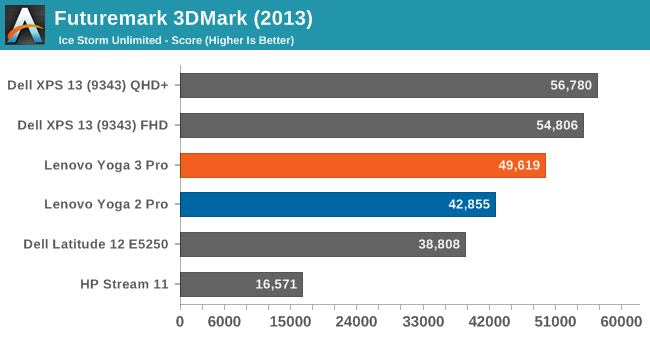
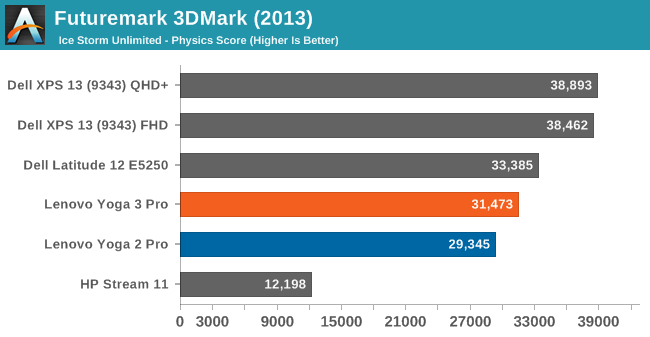
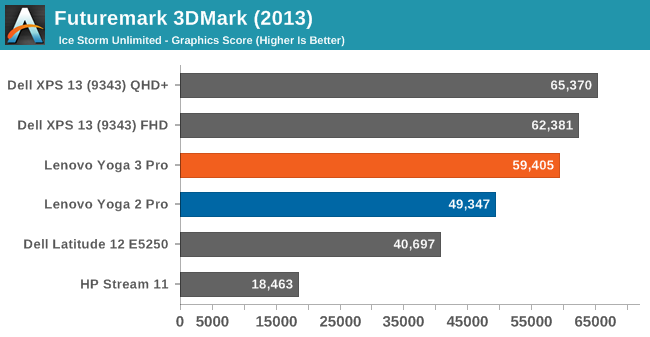
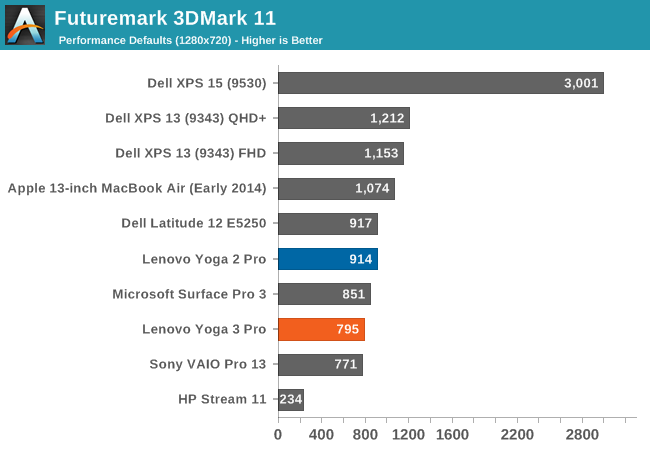
Unlike the CPU, the GPU runs out of headroom much quicker. On any of the sustained benchmarks, the Yoga 3 Pro scores significantly down on both the Haswell-U and Broadwell-U GPUs. Ice Storm Unlimited is the outlier, since it is such a short benchmark. The Core M does improve on Haswell-U in this benchmark. However compared to the HP Stream 11 which has the Atom 5 watt processor, Core M is way ahead here. Intel will be releasing a new Atom this year, and it really cannot come soon enough. Silvermont was a big improvement for Atom, but it is way behind Core M in terms of performance.
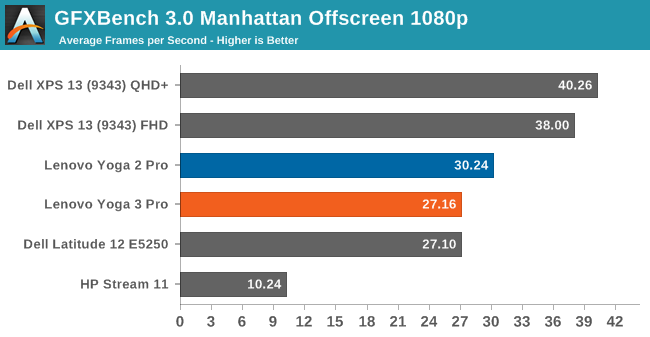

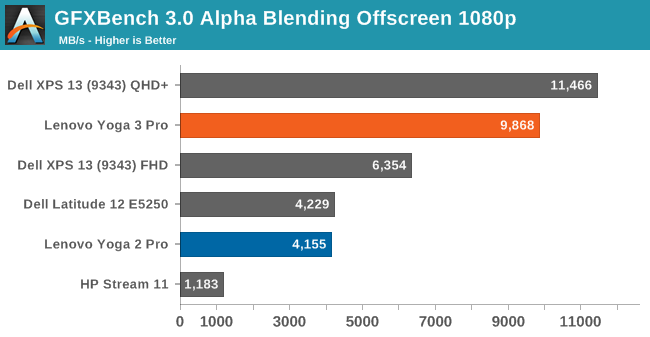
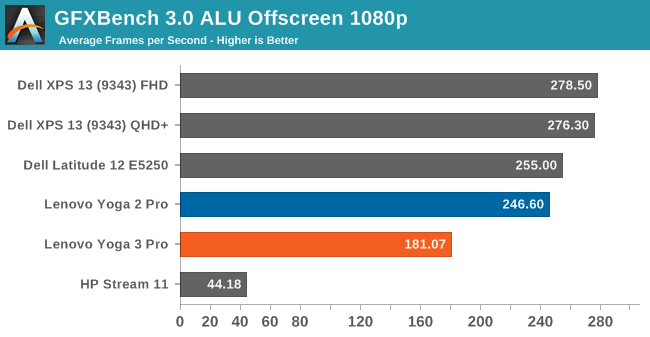

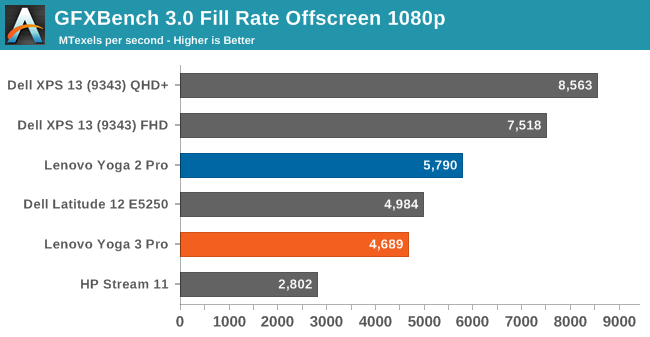

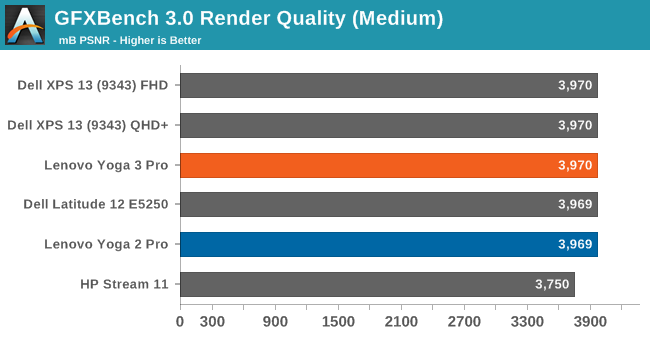
On GFXBench, we see a similar story. The 4.5 watt envelope for Core M restricts the GPU performance quite a bit, and it falls behind all of the other devices except Atom, where it destroys it. The exceptions are Driver Overhead and Alpha Blending, where newer drivers and the architectural changes of the Gen 8 graphics allow the Yoga 3 Pro to pull ahead of the Yoga 2 Pro.

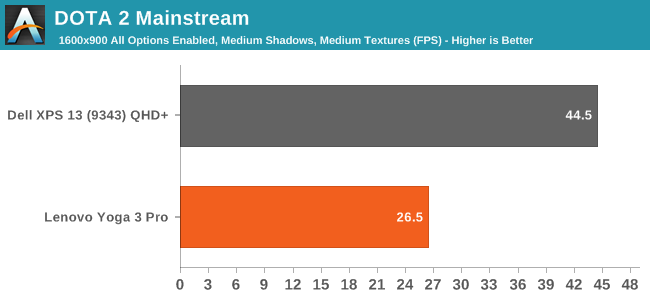
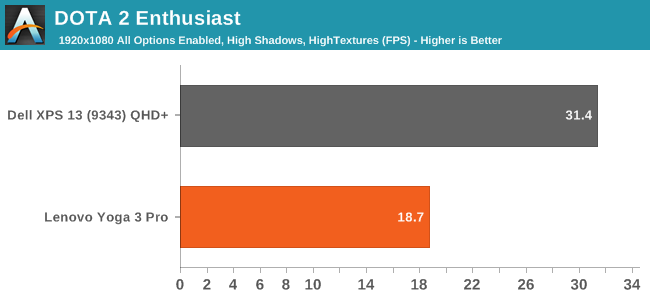
Our final GPU benchmark for Ultrabooks is our new Dota 2 Bench. We only have a single comparison at this point. The Dell XPS 13 has Broadwell-U with HD 5500 graphics. Even though both have the same number of EUs and frequencies available, it is clear the 15 watt part has a lot more headroom to allow the GPU to keep the frequency up. On Dota 2, the Yoga 3 Pro is really only playable on the Value settings, whereas the XPS 13 is over 30 FPS even on the Enthusiast settings.
For the CPU performance, Core M shows that it has the legs to compete against Haswell-U, but on the GPU side of the fence it is a different story. Core M hits the TDP limit much quicker and performance takes a nose dive. Intel still has quite a bit of work left to do on the GPU side.
Even though this is not a pure tablet, it can be used in tablet mode, so we can compare it to those devices as well.
Tablet Comparison
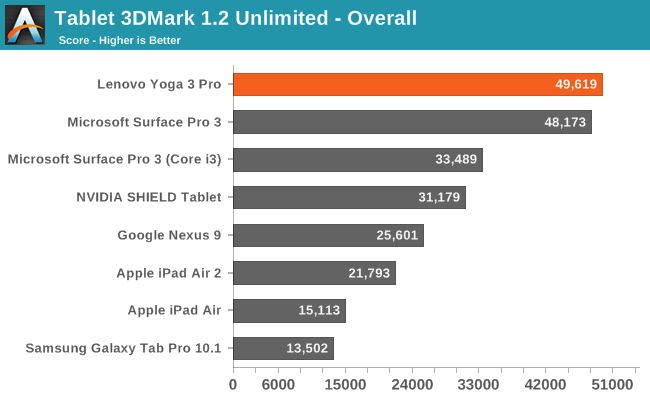
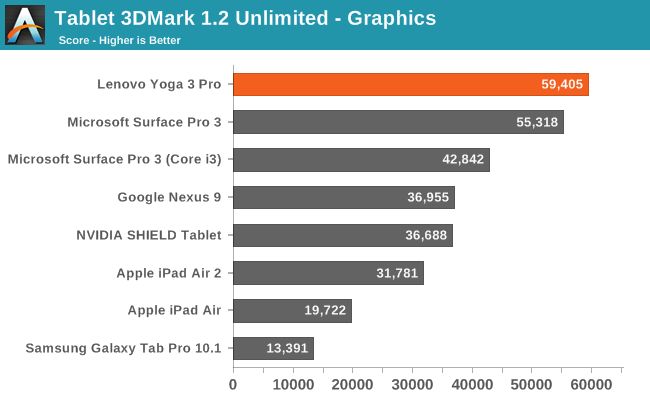

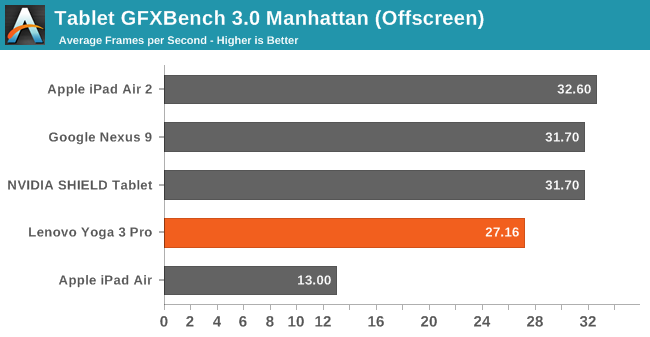

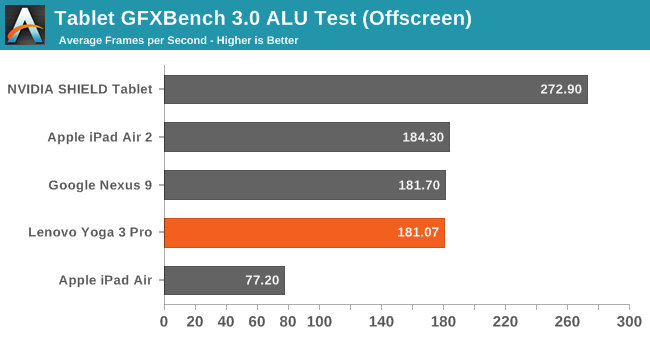
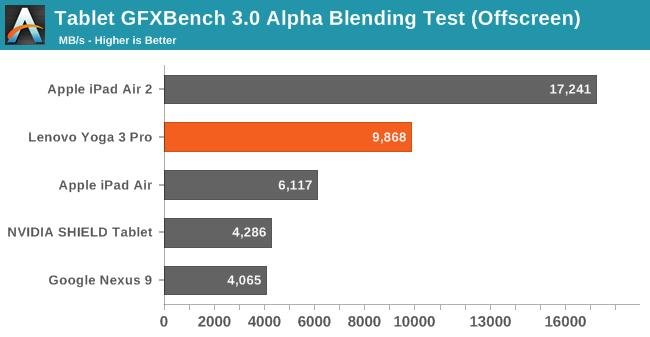

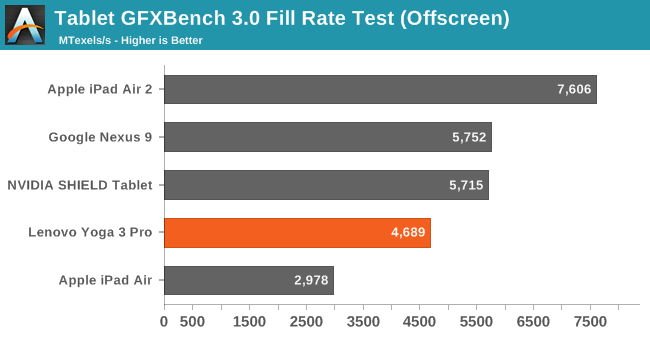
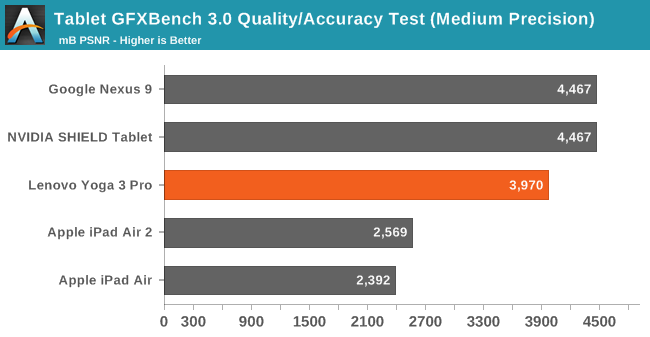
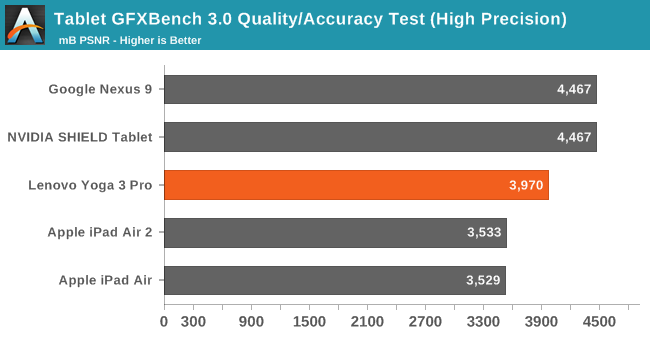
The typical tablet SoC will be very similar to the Core M processor as far as TDP. Though none of the tablets will advertise TDP, under load it is going to be fairly close to 5 watts or so. Some of the higher performance tablets may even pull a bit more power. We see some different results looking at the different benchmarks. 3DMark is very much a win for Core M’s GPU, but the benchmark is very short. It shows the potential for the HD 5300, but on any sustained workloads it bumps into the TDP fairly quickly and the scores go down.
Of note from the 3DMarks scores though is the Physics score, which is a CPU score. Core M has quite a jump in performance compared to the average Tablet SoC. This also is obvious when you compare the web tests between the Core M and a tablet. For instance, the Apple iPad Air 2 scores 4014.3 in Kraken, and the Yoga 3 Pro scores 1729.7 (lower is better – it is a score in milliseconds). WebXPRT is 1728 on the Yoga 3 Pro, but the iPad Air 2 only scores 688 (higher is better) and A8X has three CPUs versus two in Core M. Apple has been touted as having one of the best SoC CPUs, but they are no match for Intel in this arena.
The GPU side is not as rosy though, with the GFXBench scores placing HD 5300 well behind the top tablet GPUs of today. The performance potential is there for HD 5300, but it needs more TDP to exploit it with the current architecture. This is an area where Intel has been upgrading every single year, but the GPU being integrated into the CPU means that GPU updates have to wait for new product launches.










113 Comments
View All Comments
Zizy - Friday, March 13, 2015 - link
Core M seems to be a mixed bag. Great if you want short bursts of activity but fails when you demand any longer activity, especially a GPU one. Fine for netbooks, but spending 1k+ to get a tablet class of performance seems pointless to me.XPS 13 has better performance and normalized battery life. What is wrong with Yoga?
Will you also make an in-depth CPU test?
Drumsticks - Friday, March 13, 2015 - link
The performance of the core M 5Y71 parts is leavig me feeling a little bit better for a potential core m SP4. Still, this was with a fan - fanless performance is sure to be worse, and if you have a fan you might as well use the full voltage part!But in any case, I really hope that Windows 10 and Core M skylake can coincide. A skylake Surface Pro 4 in a fanless design could seriously be amazing without sacrificing performance compared to Haswell-U.
mkozakewich - Saturday, March 14, 2015 - link
The funny thing is that it's pretty much always about the cooling. A 5W TDP part works in a 5W TDP case, but it would be helpful to know what the maximum TDP is for turbo workloads. If the SP4 still has a fan and it could push 15 W out, you'd probably get the full performance without throttling.lilmoe - Friday, March 13, 2015 - link
I've never really understood Core M and its value proposition. Maybe current applications aren't optimal. Since ^this ultrabook has a fan, I just can't seem to understand why they didn't wait it out a bit and went with a cheaper Broadwell U that races to sleep much faster. In that aspect, Dell got it right with their XPS 13. No one talks about how thin this device is, especially that it's thinner than Apple's new MacBook. I can't even justify the price to performance ratio even for a fanless Windows x86 tablet. Microsoft should stick with Broadwell U for the SP4 to maintain a performance upgrade at the least.I don't know, Core M probably only has value for those who want an expensive, fanless machine, and this only works for Apple most of the time.
name99 - Friday, March 13, 2015 - link
How do you get that it's thinner than new Macbook?MacBook tapers from 13.2mm to 3.6mm. This is a flat 1.28mm. On "average" MacBook is thinner, and visually it looks far thinner.
lilmoe - Friday, March 13, 2015 - link
Since that seems the only thing you got out of my post, I'm sorry to have offended you...N000RM - Friday, March 13, 2015 - link
Would you say a two penny nail is thin because it tapers to a point? The Yoga is thinner and lighter, fanboi.michael2k - Friday, March 13, 2015 - link
The Yoga is over half a pound heavier. You also fail to understand how triangles work. The Yoga is 1.28cm more or less across the whole laptop. The MacBook is 0.35 to 1.31cm. If we assume the delta is defined by a triangle then it will be 0.48 in average height if they could flatten it's volume, or a total height of 0.83cm, again, if they could squeeze the whole design into a rectangle. And if Apple updates the MacBook Pro, next year, with similar technology it will likely be a straight 1.31cm across.wolfemane - Monday, March 16, 2015 - link
There is a sign on the door that says to leave all Jr. Math Awards with the attendant before entering Anandtech. Obviously you didn't see that... hmmmm... what to do, what to do.heron_kusanagi - Monday, March 16, 2015 - link
I don't know, performance is one thing, but if all you are doing is Office work, maybe some web surfing and casual games, Core M's proposition is ideal.The Asus UX305 (which I hope Anandtech reviews next) is using the Core M, and for the most part, it works as a ultrabook with no added sound profile to it. And its pretty cheap too.